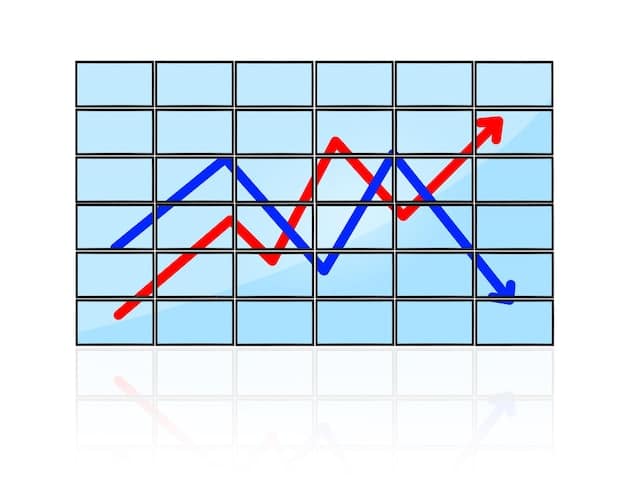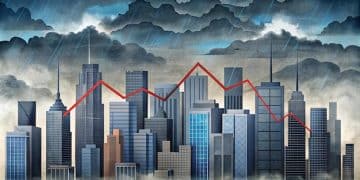Unemployment Rate Stays at 3.7%: Key Insights for US Economy

Breaking: The US unemployment rate remains steady at 3.7%, signaling a resilient labor market amidst economic uncertainties, prompting a deeper analysis of its implications for financial stability and future economic policies.
The latest jobs report reveals that the unemployment rate remains steady at 3.7%, a figure that invites us to delve deeper into the nuances of the US economy and what it signifies for American households and businesses.
Unemployment Rate Holds Steady: Initial Reactions
The US unemployment rate has remained unchanged at 3.7%, a figure that prompts questions about the current state and future of the American economy. This stability, however, should be analyzed within the broader context of economic indicators and ongoing global events.
Several factors contribute to the unemployment rate, including job creation, workforce participation, and the overall health of various industries. Understanding these components is essential for a comprehensive economic assessment.
Key Factors Influencing the Rate
The labor force participation rate and the types of jobs being created are crucial in understanding the steadiness of the unemployment rate.
- Labor Force Participation: A stable participation rate indicates that people are neither discouraged nor overly confident about job prospects.
- Job Creation Sectors: Growth in specific sectors, like healthcare or technology, can absorb job losses in others, maintaining overall stability.
- Government Policies: Unemployment benefits and job training programs can influence how quickly people find new employment.
In conclusion, while a steady unemployment rate might initially seem positive, a closer examination reveals intricate dynamics and potential challenges that require continuous monitoring and adaptive policies.
Sector-by-Sector Analysis: Where Are the Jobs?
A stagnant unemployment rate doesn’t always indicate uniform economic health across all sectors. Certain industries may be thriving while others struggle, leading to shifts in employment opportunities and workforce demands. Understanding these variances is key to a more nuanced economic perspective.
Diving into specific sector performances allows for identifying emerging trends, pinpointing areas of concern, and tailoring strategies to foster growth where it’s most needed. This detailed insight is vital for businesses, policymakers, and job seekers alike.

Growth and Decline
Different sectors experience varying rates of growth, impacting job availability and skill requirements.
- Technology: Continued innovation and digital transformation are propelling growth in the tech sector.
- Healthcare: An aging population and advancements in medical technology drive the demand for healthcare professionals.
- Retail: Shifts in consumer behavior and the rise of e-commerce affect employment in traditional retail settings.
Ultimately, a sector-by-sector analysis provides a valuable assessment of where the jobs are and where they are disappearing, offering actionable insights for adapting to the changing economic landscape.
Demographic Breakdown: Who Is Unemployed?
The unemployment rate can vary widely among different demographic groups, reflecting systemic disparities and barriers to employment. Analyzing these differences is crucial for understanding the social implications of unemployment and addressing inequality.
Understanding which groups are disproportionately affected by unemployment is essential for crafting inclusive policies and programs that promote equitable access to job opportunities and economic advancement.
Disparities Across Groups
Analyzing unemployment data across demographic lines reveals significant variations.
- Age: Younger workers often face higher unemployment rates due to lack of experience and entry-level positions.
- Race and Ethnicity: Some racial and ethnic groups experience consistently higher unemployment rates due to systemic inequalities.
- Education: Individuals with lower levels of education tend to have higher unemployment rates compared to those with advanced degrees.
By addressing the specific challenges faced by each demographic group, policymakers and organizations can work towards creating a more inclusive and equitable labor market.
The Impact of Inflation and Interest Rates
Inflation and interest rates play significant roles in shaping the labor market and influencing the unemployment rate. Understanding how these economic factors interact is essential for forecasting future employment trends.
Analyzing the relationships between inflation, interest rates, and unemployment provides valuable insights for businesses, investors, and individuals navigating the complexities of the modern economy.

Economic Levers
Controlling inflation and managing interest rates directly impact business investment and consumer spending, thus affecting employment.
- Inflationary Pressures: High inflation can lead to reduced consumer spending, impacting businesses and potentially increasing unemployment.
- Interest Rate Hikes: Higher interest rates can slow down business investment and hiring, also potentially increasing unemployment.
- Monetary Policy: Central banks use monetary policy tools to balance inflation and employment, influencing the overall economic environment.
In short, a comprehensive understanding of the interaction between inflation, interest rates, and unemployment is vital for making informed economic decisions.
Future Projections: What Lies Ahead?
Predicting the future of the labor market involves considering various factors, including technological advancements and shifting global dynamics. While precise forecasts are challenging, understanding potential scenarios prepares us for the uncertainties ahead.
Examining possible future trends not only aids in economic planning but also empowers individuals and businesses to adapt proactively, ensuring resilience in a rapidly changing world.
Trends to Watch
Several key trends could influence future unemployment rates.
- Technological Automation: Increased automation may displace workers in some sectors while creating new opportunities in others.
- Globalization: Global economic conditions and trade policies can significantly impact domestic employment.
- Demographic Changes: An aging workforce and evolving skill requirements will shape the future of work.
In conclusion, staying informed about these trends and adapting accordingly will be crucial for navigating the future labor market successfully.
Policy Implications: Government Responses
Government policies play a key role in mitigating unemployment and supporting workers during economic downturns. Examining these policies and their effectiveness is vital for fostering a stable and inclusive labor market.
A review of government interventions offers insights into what works, what doesn’t, and how policies can be refined to maximize their positive impact on employment and economic stability.
Government Interventions
Various government initiatives aim to reduce unemployment and support workforce development.
- Unemployment Benefits: Providing temporary financial assistance to unemployed workers.
- Job Training Programs: Equipping workers with skills needed for in-demand industries.
- Infrastructure Investments: Creating jobs through public works projects.
By thoughtfully evaluating and adjusting these policies, governments can create a more resilient and supportive environment for workers and businesses alike.
| Key Point | Brief Description |
|---|---|
| 📊 Steady Unemployment | Rate remains at 3.7%, indicating labor market resilience. |
| 💼 Sector Variances | Tech and healthcare are growing, while retail faces challenges. |
| 📈 Inflation Impact | Inflation and interest rates influence job creation and spending. |
| 🔮 Future Trends | Automation and globalization will shape job markets. |
[Retractable FAQ Section]What does the 3.7% unemployment rate signify for the US economy?
▼
The 3.7% rate indicates a relatively tight labor market, suggesting that businesses are still hiring and the economy is maintaining a steady pace of growth, despite some economic headwinds.
▼
Sectors such as healthcare, technology, and leisure and hospitality have been significant contributors to job growth, driven by increased demand and recovering from pandemic-related setbacks.
▼
Elevated inflation and rising interest rates can potentially slow economic growth, which may lead to companies reducing hiring or even laying off workers, thus increasing the unemployment rate.
▼
Unemployment insurance provides temporary financial assistance to eligible individuals who have lost their jobs. Additionally, job training programs aim to help people gain new skills and find employment.
▼
Future projections vary, but many economists anticipate a modest increase in the unemployment rate as the economy cools down. However, the exact trajectory will depend on various factors like consumer spending.
Conclusion
In conclusion, the steady unemployment rate of 3.7% is a snapshot of a dynamic and complex economic landscape. While it signals current stability, it’s crucial to monitor sector-specific changes, demographic variations, and the influence of broader economic factors like inflation and interest rates to fully understand and proactively address future trends.





